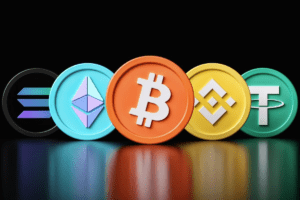Zrozumienie Solany
Solana to wysokowydajny blockchain platforma zaprojektowany, aby umożliwić szybkie i bezpieczne zdecentralizowane aplikacje (dApps) i kryptowaluty. Dzięki innowacyjnej technologii i skupieniu się na skalowalności, sieć główna Solana przyciągnęła uwagę społeczności blockchain.
Wprowadzenie do Solana
Solana została założona w 2017 roku przez Anatolija Yakovenko, byłego inżyniera w Qualcomm. Platforma ma na celu zaradzenie ograniczeniom skalowalności i szybkości, z którymi boryka się wiele sieci blockchain. Solana osiąga to dzięki połączeniu unikalnych technologii i decyzji projektowych.
Potęga sieci głównej Solana
Mainnet Solany to sieć na żywo, w której realizowane są transakcje i inteligentne kontrakty. Służy jako podstawa ekosystemu Solana, wspierając szeroką gamę aplikacji i usług.
Jedną z kluczowych zalet sieci głównej Solana jest jej skalowalność. Tradycyjne sieci blockchain często zmagają się z ograniczoną przepustowością transakcji, co skutkuje zatorami i wysokimi opłatami w okresach wysokiego popytu. Solana pokonuje te wyzwania, wykorzystując unikalną architekturę, która może obsługiwać tysiące transakcji na sekundę. Ta wysoka przepustowość transakcji jest osiągana dzięki połączeniu przetwarzania równoległego i mechanizmu konsensusu Proof-of-History (PoH).
Solana's PoH to nowatorskie podejście, które umożliwia sieci osiągnięcie konsensusu w sprawie kolejności transakcji bez konieczności przetwarzania każdej transakcji przez wszystkie węzły. Skutkuje to wydajną walidacją i zwiększoną przepustowością sieci, umożliwiając Solanie obsługę dużej liczby transakcji w krótkim czasie.
Dodatkowo, sieć główna Solana priorytetowo traktuje bezpieczeństwo i decentralizację. Platforma wykorzystuje zaawansowane techniki kryptograficzne i solidne środki bezpieczeństwa w celu ochrony środków użytkowników i zapewnienia integralności sieci. Model bezpieczeństwa Solany został zaprojektowany tak, aby wytrzymać różne rodzaje ataków, zapewniając bezpieczne środowisko dla użytkowników i programistów.
Aby jeszcze bardziej wzmocnić ekosystem Solana, platforma oferuje szereg narzędzi i zasobów dla programistów. Narzędzia te upraszczają proces tworzenia i wdrażania dApps w sieci głównej Solana, umożliwiając programistom uwolnienie swojej kreatywności i przyczynienie się do rozwoju ekosystemu. Więcej informacji na temat narzędzi i zasobów deweloperskich Solana można znaleźć w naszym artykule na temat ekosystem solana.
Podsumowując, sieć główna Solana to potężna platforma blockchain, która oferuje wysoką skalowalność, szybkie przetwarzanie transakcji i solidne bezpieczeństwo. Innowacyjna technologia i przyjazne dla deweloperów środowisko sprawiają, że jest to atrakcyjna opcja dla osób i organizacji chcących tworzyć zdecentralizowane aplikacje. Ponieważ Solana nadal ewoluuje i zyskuje na popularności, jej sieć główna jest gotowa do napędzania kolejnej fali innowacji w przestrzeni blockchain.
Eksploracja sieci głównej Solana
Aby zrozumieć sieć główną Solana, ważne jest, aby zrozumieć koncepcję sieci głównej i zbadać funkcje i możliwości oferowane przez sieć główną Solana.
Czym jest sieć Mainnet?
W świecie technologii blockchain, mainnet odnosi się do żywej i w pełni funkcjonalnej wersji sieci blockchain. Jest to wersja gotowa do produkcji, w której wykonywane są transakcje, wdrażane są inteligentne kontrakty i budowane są zdecentralizowane aplikacje (dApps). Mainnet umożliwia użytkownikom interakcję z siecią blockchain w bezpieczny i zdecentralizowany sposób.
Sieć główna Solana jest kręgosłupem ekosystemu blockchain Solana. Jest to sieć, w której uczestnicy mogą dokonywać transakcji, tworzyć i wdrażać inteligentne kontrakty oraz budować innowacyjne aplikacje. Sieć główna Solana zapewnia niezawodną i solidną infrastrukturę dla programistów, firm i użytkowników, aby wykorzystać moc technologii blockchain.
Funkcje i możliwości sieci głównej Solana
Sieć główna Solana oferuje kilka funkcji i możliwości, które odróżniają ją od innych sieci blockchain. Obejmują one:
Skalowalność i szybkość
Sieć główna Solana została zaprojektowana z myślą o skalowalności, oferując wysoką przepustowość transakcji i niskie opóźnienia. Może przetwarzać niezwykłą liczbę transakcji na sekundę (TPS), co czyni ją jedną z najszybszych istniejących sieci blockchain. Skalowalność sieci głównej Solana została osiągnięta dzięki połączeniu innowacyjnych technologii i algorytmów konsensusu, takich jak Proof-of-History (PoH) i Tower BFT (Byzantine Fault Tolerance). Technologie te zapewniają, że Solana może obsłużyć dużą liczbę transakcji bez poświęcania szybkości lub bezpieczeństwa.
Więcej informacji na temat skalowalności Solany można znaleźć w naszym artykule na temat Skalowalność Solana.
Bezpieczeństwo i decentralizacja
Sieć główna Solana priorytetowo traktuje bezpieczeństwo i decentralizację. Wykorzystuje unikalny algorytm konsensusu o nazwie Proof-of-History (PoH), który zapewnia chronologiczny dowód zdarzeń w łańcuchu bloków. PoH umożliwia Solanie szybką walidację transakcji i utrzymanie wysokiego poziomu bezpieczeństwa. Ponadto podejście Solany do bezpieczeństwa obejmuje takie środki, jak techniki kryptograficzne i regularne audyty w celu zminimalizowania ryzyka luk w zabezpieczeniach.
Aby uzyskać więcej informacji na temat środków bezpieczeństwa Solana, możesz zapoznać się z naszym artykułem na temat Podejście Solany do bezpieczeństwa.
Narzędzia i zasoby dla deweloperów
Sieć główna Solana oferuje szereg narzędzi deweloperskich i zasobów ułatwiających tworzenie zdecentralizowanych aplikacji. Deweloperzy mogą wykorzystać oprogramowanie Development Kit (SDK), który zapewnia niezbędne narzędzia, biblioteki i dokumentację do budowania na blockchainie Solana. SDK upraszcza proces rozwoju, pozwalając programistom skupić się na tworzeniu innowacyjnych rozwiązań opartych na blockchainie.
Aby zapoznać się z dostępnymi narzędziami i zasobami dla deweloperów, odwiedź nasz artykuł na stronie Narzędzia i zasoby deweloperskie Solana.
Przykłady projektów w sieci głównej Solana
Sieć główna Solana przyciągnęła tętniący życiem i rozwijający się ekosystem projektów i aplikacji. Od zdecentralizowanych giełd po zdecentralizowane platformy finansowe (DeFi), różne projekty zostały zbudowane w sieci głównej Solana. Projekty te wykorzystują szybkość, skalowalność i bezpieczeństwo Solany, aby zapewnić wydajne i przyjazne dla użytkownika rozwiązania.
Aby lepiej zrozumieć projekty i aplikacje w sieci głównej Solana, możesz zapoznać się z naszym artykułem na temat Ekosystem Solany.
Sieć główna Solana służy jako potężna podstawa dla programistów i użytkowników, aby wykorzystać potencjał technologii blockchain. Dzięki skalowalności, szybkości, bezpieczeństwu i przyjaznemu dla deweloperów ekosystemowi, sieć główna Solana otwiera świat możliwości dla zdecentralizowanych innowacji.
Skalowalność i szybkość
Jeśli chodzi o sieci blockchain, skalowalność i szybkość są kluczowymi czynnikami decydującymi o ich skuteczności i użyteczności. Sieć główna Solana odpowiada na te wyzwania, zapewniając wysoką przepustowość transakcji i wykorzystując innowacyjny algorytm konsensusu.
Wysoka przepustowość transakcji Solana
Sieć główna Solana jest znana z wyjątkowej przepustowości transakcji, która odnosi się do liczby transakcji, które sieć może przetworzyć w określonym czasie. Solana osiąga wysoką przepustowość dzięki wykorzystaniu unikalnej kombinacji technologii i zasad projektowania.
Dzięki sieci głównej Solana użytkownicy mogą doświadczać prędkości transakcji sięgających tysięcy transakcji na sekundę (TPS). Jest to możliwe dzięki połączeniu kilku kluczowych komponentów:
-
Przetwarzanie równoległe: Solana wykorzystuje technikę zwaną przetwarzaniem równoległym, w której wiele transakcji jest przetwarzanych jednocześnie. Podejście to pozwala na efektywne wykorzystanie zasobów obliczeniowych, znacznie zwiększając przepustowość transakcyjną sieci.
-
Dowód historii: Solana wprowadza nowatorską funkcję o nazwie Proof-of-History (PoH), która zapewnia weryfikowalny zapis czasu dla każdej transakcji. Włączając PoH, Solana eliminuje potrzebę tradycyjnych mechanizmów konsensusu, aby osiągnąć porozumienie w sprawie kolejności transakcji. Pozwala to na szybszą walidację transakcji i późniejsze potwierdzenie bloku.
-
Tower BFT Consensus: Sieć główna Solana wykorzystuje algorytm konsensusu o nazwie Tower BFT (Byzantine Fault Tolerance). Ten mechanizm konsensusu umożliwia sieci osiągnięcie konsensusu szybko i skutecznie, co dodatkowo przyczynia się do wysokiej przepustowości transakcji.
Aby spojrzeć na wysoką przepustowość transakcji Solany z innej perspektywy, tradycyjne sieci blockchain, takie jak Bitcoin oraz Ethereum zazwyczaj obsługują tylko kilka transakcji na sekundę. Zdolność Solany do przetwarzania znacznie większej liczby transakcji sprawia, że dobrze nadaje się ona do zastosowań wymagających szybkich i skalowalnych rozwiązań blockchain.
Algorytm konsensusu Solany
Algorytm konsensusu Solana, Tower BFT, odgrywa istotną rolę w zapewnianiu bezpieczeństwa i wydajności sieci. Tower BFT to wariant klasycznego algorytmu konsensusu Practical Byzantine Fault Tolerance (PBFT), zaprojektowany specjalnie na potrzeby Solany.
Tower BFT umożliwia Solanie szybkie i niezawodne osiągnięcie konsensusu między walidatorami sieci. Walidatory w sieci Solana współpracują ze sobą w celu walidacji transakcji i zabezpieczenia sieci. Dzięki algorytmowi konsensusu Tower BFT, Solana zapewnia, że wszyscy walidatorzy zgadzają się co do stanu łańcucha bloków, umożliwiając spójną i bezpieczną sieć.
Dzięki zastosowaniu Tower BFT, Solana jest w stanie osiągnąć krótkie czasy potwierdzania bloków, umożliwiając niemal natychmiastową finalizację transakcji. Oznacza to, że transakcje w sieci głównej Solana są potwierdzane i nie można ich cofnąć w ciągu kilku sekund, zapewniając użytkownikom płynne i wydajne doświadczenie.
Dzięki wysokiej przepustowości transakcji i innowacyjnemu algorytmowi konsensusu, sieć główna Solana wyróżnia się jako skalowalna i szybka sieć blockchain. Te cechy sprawiają, że Solana jest atrakcyjnym wyborem dla deweloperów i firm, które chcą tworzyć zdecentralizowane aplikacje wymagające szybkiego i wydajnego przetwarzania transakcji. Aby dowiedzieć się więcej o ekosystemie Solany, tokenomice i innych szczegółach technicznych, odwiedź nasze obszerne artykuły na temat tokenomika solana oraz skalowalność solana.
Bezpieczeństwo i decentralizacja
Jeśli chodzi o sieci blockchain, bezpieczeństwo i decentralizacja mają kluczowe znaczenie. Mainnet Solany został zaprojektowany z myślą o tych zasadach, wykorzystując innowacyjne technologie w celu zapewnienia integralności i bezpieczeństwa sieci.
Dowód historii Solany
Jednym z kluczowych elementów przyczyniających się do bezpieczeństwa Solany jest jej unikalny algorytm konsensusu, znany jako Proof-of-History (PoH). PoH to weryfikowalna funkcja opóźnienia, która umożliwia sieci efektywne porządkowanie transakcji i ustanowienie liniowej osi czasu wydarzeń. Wykorzystując ten algorytm, Solana zapewnia, że kolejność transakcji jest dokładnie rejestrowana i zapobiega wszelkim manipulacjom lub manipulowaniu historią transakcji.
Algorytm Proof-of-History znacząco zwiększa bezpieczeństwo sieci Solana Mainnet, zapewniając wiarygodny i niezmienny zapis wszystkich transakcji. Gwarantuje to, że sieć pozostaje odporna na ataki i utrzymuje integralność danych przechowywanych w łańcuchu bloków. To innowacyjne podejście do tworzenia spójnej historii transakcji odróżnia Solanę od tradycyjnych sieci blockchain.
Podejście Solany do bezpieczeństwa
Oprócz algorytmu Proof-of-History, Solana wykorzystuje kilka innych środków bezpieczeństwa w celu ochrony sieci i jej uczestników. Solana wykorzystuje bizantyjski mechanizm konsensusu odporny na błędy, co oznacza, że sieć może nadal działać wydajnie i bezpiecznie, nawet w obecności złośliwych aktorów lub węzłów.
Co więcej, Mainnet Solany korzysta z ciągłego monitorowania i audytu przez sieć walidatorów. Walidatory odgrywają kluczową rolę w utrzymaniu bezpieczeństwa i decentralizacji sieci. Weryfikują transakcje, proponują nowe bloki i zapewniają, że sieć działa zgodnie z ustalonymi zasadami. Walidatorzy są wybierani na podstawie ich reputacji, niezawodności i wiedzy specjalistycznej, zapewniając, że sieć pozostaje solidna i odporna na ataki.
Wdrażając te środki bezpieczeństwa, Solana wzmacnia zaufanie swoich użytkowników, zapewniając bezpieczne środowisko dla rozwoju zdecentralizowanych aplikacji (dApps) i transakcji.
Podsumowując, sieć Solana Mainnet priorytetowo traktuje bezpieczeństwo i decentralizację poprzez wykorzystanie innowacyjnych technologii, takich jak algorytm Proof-of-History i bizantyjski mechanizm konsensusu odporny na błędy. Środki te zapewniają integralność sieci i stanowią bezpieczną podstawę do rozwoju i wykonywania zdecentralizowanych aplikacji. Aby dowiedzieć się więcej o tokenomice i ekosystemie Solana, odwiedź nasze artykuły na temat Solana tokenomics oraz Ekosystem Solana.
Opierając się na sieci głównej Solana
Sieć Mainnet firmy Solana zapewnia solidną i skalowalną platformę dla programistów do tworzenia zdecentralizowanych aplikacji (dApps) i projektów. Dzięki wysokowydajnej architekturze i zaawansowanym funkcjom, Solana oferuje szereg narzędzi i zasobów dla programistów, które wspierają tworzenie innowacyjnych rozwiązań w sieci Mainnet.
Narzędzia i zasoby dla programistów Solana
Solana oferuje kompleksowy zestaw narzędzi i zasobów dla programistów, aby ułatwić proces rozwoju i zwiększyć możliwości projektów zbudowanych w sieci Mainnet. Narzędzia te zapewniają programistom niezbędną infrastrukturę i wsparcie, aby uwolnić ich kreatywność i tworzyć skalowalne aplikacje.
Jednym z kluczowych narzędzi deweloperskich dostarczanych przez Solanę jest Solana Software Development Kit (SDK). SDK oferuje zestaw bibliotek i interfejsów API, które umożliwiają programistom interakcję z blockchainem Solana i tworzenie zdecentralizowanych aplikacji. Stanowi on podstawę do tworzenia inteligentnych kontraktów, zarządzania transakcjami i integracji różnych funkcji z projektami opartymi na Solanie.
Oprócz SDK, Solana oferuje bogaty zestaw dokumentacji i samouczków, które prowadzą programistów przez proces tworzenia w sieci głównej Solana. Dokumentacja obejmuje różne tematy, w tym konfigurację środowiska programistycznego, zrozumienie architektury Solana i wdrażanie inteligentnych kontraktów. Zasoby te zapewniają programistom wiedzę i wskazówki potrzebne do skutecznego wykorzystania możliwości Solany.
Ponadto Solana organizuje regularne hackathony, warsztaty i wydarzenia, aby wspierać zaangażowanie społeczności i zachęcać programistów do odkrywania potencjału budowania na Solanie. Wydarzenia te zapewniają możliwości nawiązywania kontaktów, uczenia się i prezentowania innowacyjnych projektów. Aktywnie uczestnicząc w społeczności programistów Solana, deweloperzy mogą uzyskać dostęp do cennych spostrzeżeń, współpracować z podobnie myślącymi osobami i być na bieżąco z najnowszymi osiągnięciami w ekosystemie Solana.
Przykłady projektów w sieci głównej Solana
Sieć Solana Mainnet przyciągnęła różnorodne projekty, które wykorzystują jej skalowalność i wysoką przepustowość transakcji. Projekty te obejmują różne sektory, w tym zdecentralizowane finanse (DeFi), niewymienialne tokeny (NFT), gry i wiele innych. Oto kilka godnych uwagi przykładów:
| Nazwa projektu | Opis |
|---|---|
| Serum | Zdecentralizowana giełda (DEX) zbudowana na platformie Solana, oferująca szybkie i tanie transakcje. handel zasobów cyfrowych. |
| Rynki Mango | Zdecentralizowany protokół finansowy, który umożliwia użytkownikom handel, pożyczać i pożyczać aktywa na Solana. |
| Raydium | Zautomatyzowany animator rynku (AMM) i dostawca płynności na Solanie, ułatwiający efektywne swapy tokenów i yield farming. |
| Rozpuszczalny | Platforma do tworzenia i handlu niewymienialnymi tokenami (NFT) na Solanie, wzmacniająca pozycję artystów i kolekcjonerów. |
Projekty te podkreślają różnorodność możliwości, jakie sieć Mainnet Solana zapewnia deweloperom. Wykorzystując moc zaawansowanych funkcji i infrastruktury Solany, projekty te przesuwają granice tego, co jest możliwe w przestrzeni blockchain.
Budowanie w sieci głównej Solana otwiera przed programistami świat możliwości tworzenia innowacyjnych i skalowalnych aplikacji. Dzięki narzędziom deweloperskim, zasobom i tętniącej życiem społeczności, Solana zapewnia wspierające środowisko do przekształcania pomysłów w rzeczywistość. Niezależnie od tego, czy jesteś doświadczonym programistą, czy dopiero zaczynasz swoją przygodę, Solana oferuje narzędzia i zasoby, aby uwolnić swój potencjał i tworzyć wpływowe projekty.



